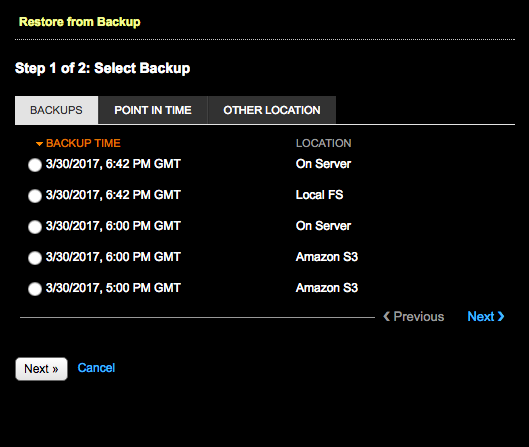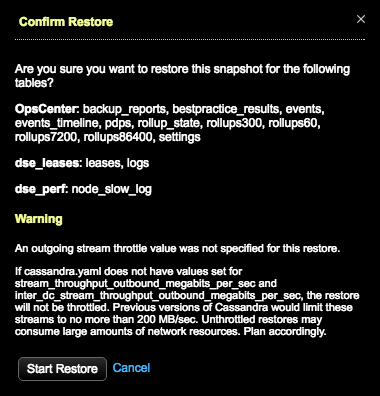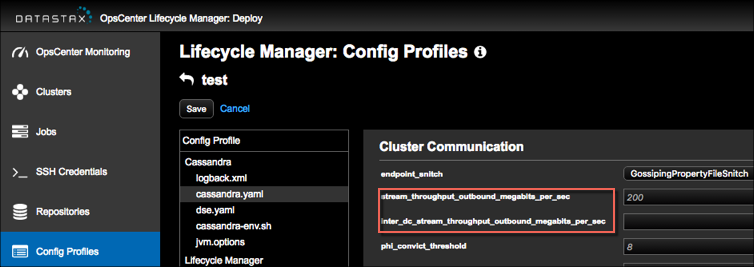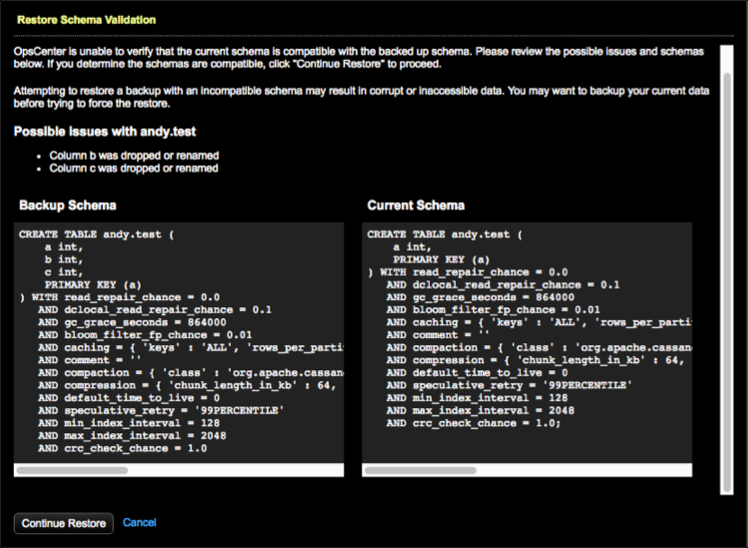Restore from a backup
Restore data from supported backups that have been run by OpsCenter. You cannot use the OpsCenter Backup Service to restore from snapshots run with nodetool. You can pick any subset of tables that exist in the snapshot to restore.
Prerequisites
-
To restore encrypted backups, the DataStax agent must be granted password-less sudo access on the DataStax Enterprise nodes. This access has already been granted if you used OpsCenter to install the DataStax agents. If you are running the agent as a different user than the default and need to restore encrypted tables, you must manually restore the
system_keytable. -
When restoring tables that are Solr cores, if the table does not already exist, it will be automatically re-created as a CQL table. If you require this to be a thrift-based table, manually recreate the table prior to restoring. If you are restoring data from a thrift table that no longer exists, you are responsible for creating the table prior to restoring.
|
The Backup Service requires control over the data and structure of its destination locations. The backup destinations must be dedicated for use only by OpsCenter. Any additional directories or files in those destinations can prevent the Backup Service from properly conducting a Backup or Restore operation. |
|
Keep the following caveats in mind when creating and restoring backups:
|
Procedure
-
Select cluster name > Services.
-
Select the Details link for the Backup Service.
-
In the Activity tab, click Restore Backup.
The Restore from Backup dialog appears.

-
Select the tab that correlates to the type of backup to restore.
-
Select the keyspace to restore from the Backups tab. The list includes both scheduled and manual backups.
-
Select Other Location to restore from a location not listed in the Backups tab.
Selecting a backup from Other Location is most commonly used when cloning a cluster, but can be used when this OpsCenter instance is not aware of the backup location.
-
To restore to a certain point in time, select the Point In Time tab and follow the steps in Restore a backup to a specific point in time.
-
-
Click Next.
The Restore from Backup, Step 2 of 2: Configure and Restore dialog appears.

-
In Keyspaces and Graphs, select the tables or graphs you want to restore.
-
Click All Keyspaces or All Graphs to restore all keyspaces or all graphs.
-
Click the keyspace name or graph name to include all tables or all graphs in the keyspace.
-
To select specific tables or graphs, expand the keyspace name or graph name and select the specific tables or graphs to back up.
For DSE 6.0.0-6.0.4, when restoring a DSE Graph backup without selecting Use sstableloader, DSE must be restarted to ensure all data is available.
-
-
Under Location, select the target cluster for the restored data.
-
The Location list is only available when there are multiple clusters and both clusters are managed by the same instance of OpsCenter.
-
If you select a different cluster than the one that was backed up, the data is cloned to the selected cluster. See cloning cluster data.
Restoring encrypted tables to a different cluster does not work unless the encryption keys are identical, which is typically not the case.
-
-
Optional: To remove the existing keyspace data before the data is restored, select Truncate/delete existing data before restore. This completely removes any updated data in the cluster for the keyspaces you are restoring.
Choosing to not truncate or delete existing data can be selected only when sstableloader is used for the restore. If not using sstableloader, truncating or deleting existing data is selected by default.
-
To prevent overloading the network, set a maximum transfer rate for the restore using the Throttle DSE stream throughput at __ MB option.
To enter a value for this option, you must select Use sstableloader. Otherwise, the transfer rate value is ignored.
-
To bulk load external data into a cluster, select Use sstableloader.
Using sstableloader restores data to a cluster regardless of its original topology, at the expense of speed and performance. Restoring to a cluster that uses tiered storage requires using sstableloader. See sstableloader for details.
When restoring from a backup, OpsCenter might report that the restore was successful, even if it failed. This behavior can occur when copying SSTables into the new data directories and running
nodetool refreshafterward. To determine whether the restore failed, search the DataStax Agent logs for a string indicating"Error copying sstables to data dir:". This issue is present only in OpsCenter 6.8.0. -
If necessary, change the staging directory by setting the
backup_staging_directoryconfiguration option inaddress.yaml. -
Click Restore Backup.
The Confirm Restore dialog appears.

If a value was not set for throttling stream output, a warning message indicates the consequences of unthrottled restores. Take one of the following actions:
-
Click Cancel and set the throttle value in the Restore from Backup dialog.
-
Set the
stream_throughput_outbound_megabits_per_secandinter_dc_stream_throughput_outbound_megabits_per_secvalues incassandra.yaml. -
Proceed anyway at the risk of creating network bottlenecks.
If using LCM to manage DSE cluster configuration, update Cluster Communication settings in
cassandra.yamlin the configuration profile for the cluster and run a configuration job. Stream throughput (not inter-dc) is set to 200 in LCM defaults.
-
-
Click Start Restore to confirm the restore.
If the pre-restore checks detected schema differences that could not automatically be validated, the Restore Schema Validation dialog appears. Possible issues are listed and a comparison of the backup and current schema are presented side-by-side.

-
Review the information to determine if adjustments or corrections to the current schema are required :
-
To correct schema issues, click Cancel, rectify the issues, and try the restore again.
-
To proceed despite the schema mismatch, click Continue Restore.
Attempting to restore a backup with an incompatible schema might result in corrupt or inaccessible data. Before forcing the restore, back up your current data.
-
After the restore starts, the Restore Report shows detailed information about the progress and status of the restore. The Restore Report dialog can be closed at any time without impacting the restore process. Reopen a report by clicking any ongoing or completed restore in the Activity tab.
If there is insufficient disk space to restore the backup, the restore fails. See Monitoring sufficient disk space for restoring backups.
